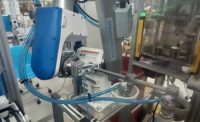Orfer Oy, founded in 1970, engineers and manufactures automated material-handling systems for a variety of industries. The Finland-based company has recently expanded, opening its North American office in Toronto. Orfer also expanded its BoxCell packing system with the BoxCellPlus, an automated packing machine for food and packaging industries.
The BoxCellPlus is designed to open flattened boxes, fold the flaps, and seal the bottom with tape and then fill the box with products—all in one economical, space-saving and fully automated packing cell. To complete the design, Orfer needed a robot that was fast, accurate and could easily integrate with a vision system.
Orfer asked TM Robotics (TMR) to help choose the right robot for the application, having worked with the supplier since 2004. Nigel Smith, CEO of TMR, helped Orfer define the robot specifications and suggested the Toshiba Machine TH650A high-speed SCARA robot for the BoxCellPlus.
“Our focus is on helping customers identify their most important system requirements and meeting those with exactly the right robot,” Smith states. “In comparison to a six-axis robot with a cycle time of five seconds, the Toshiba SCARA robot’s cycle time is approximately two seconds, which dramatically improved capacity. And it costs about 40 percent less than a spider robot.”
The TH650A uses a larger motor and high-performance RF gears on joints one and two, which are the strongest, longest-lasting gears for a SCARA arm. It also has a payload of 10 kilograms, which allows a wide range of products to be picked, while supporting a variety of tool configurations.
“A company that has multiple sizes of chicken products may need a gripper capable of picking up the one-, two-, or five-kilogram family pack,” says Jari Mäkelä, North American director at Orfer. “A single gripper for these products requires a number of components, all of which need to be considered when looking at the robot’s final payload. The 10-kilogram payload of the TH650A gives our engineers plenty of flexibility to design their end-of-arm tooling.”
To minimize the size of the BoxCellPlus, Orfer’s designers mounted the robot above the conveyor rather than on the floor. This maximized the robot’s ability to access products on the moving conveyor and place them into the box. The robot’s ability to place parts accurately within 0.01 millimeter was enhanced with an extended Z shaft of 400 millimeters that enables parts to be placed deeper into the box.
The robot also interfaces with leading vision systems, which can be used for inspection and to send coordinate data to the robot to pick parts from a moving conveyor. Orfer is able to pass along the advantages of the robot in its new BoxCellPlus system, including faster, more accurate processing, smaller size, and lower cost. According to Orfer, the BoxCellPlus can complete the work of multiple machines to build and fill boxes at a 15 to 25 percent lower cost.
“Toshiba robots have excellent product-handling capabilities, and have proven to be reliable, durable and maintenance-free,” notes Mäkelä. “And we can always count on the fantastic service and support from the TM Robotics team.”
For more information on automating processes with Toshiba robots, call 847-709-7308 or visit www.tmrobotics.com.






